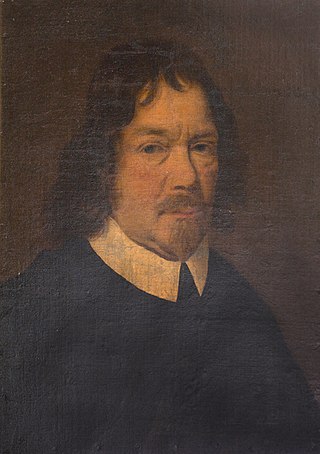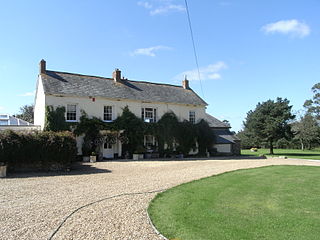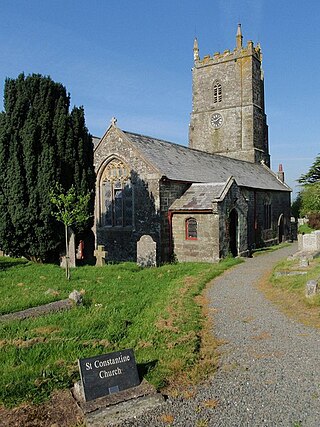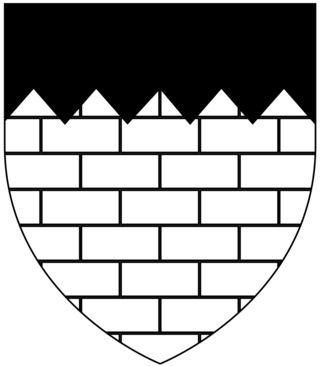Related Research Articles

Yealmpton is a village and civil parish in the English county of Devon. It is located in the South Hams on the A379 Plymouth to Kingsbridge road and is about 8 miles (13 km) from Plymouth. Its name derives from the River Yealm that flows through the village. At the 2001 census, it had a population of 1,923, falling to 1,677 at the 2011 census. There is an electoral ward of the same name. The population of this ward in 2011 was 2,049.

Tamerton Foliot is a village situated in the north of Plymouth, England, that also lends its name to the ecclesiastical parish of the same name.
Colebrooke is a village and parish in Devon, England about 8 km west of Crediton. The main point of interest is the church and the connection to Henry Kingsley's novel The Recollections of Geoffry Hamlyn. Also Uncle Tom Cobley, of the folk song, signed his will at Pascoe House, but is buried 4 miles west at Spreyton. The champion Devon wrestler, Abraham Cann was born and buried here. He won the all-comers wrestling crown in London.

Meavy is a small village, civil parish and former manor in the English county of Devon. Meavy forms part of the district of West Devon. It lies a mile or so east of Yelverton. The River Meavy runs near the village. For administrative purposes the parish is grouped with the parishes of Sheepstor and Walkhampton to form Burrator Parish Council, and for electoral purposes it is grouped with the same two parishes to form Burrator Ward.

Membury is a village three miles north west of Axminster in East Devon district. The population at the 2011 Census was 501.
Bowden is a historic estate in the parish of Yealmpton in Devon, England. From the 15th century until 1748 the manor house was for eight generations the seat of a junior branch of the Copleston family of Copplestone. The manor house was largely rebuilt in the 19th century and, together with some of its outbuildings, now serves as a farmhouse.

Tristram Risdon was an English antiquarian and topographer, and the author of Survey of the County of Devon. He was able to devote most of his life to writing this work. After he completed it in about 1632 it circulated around interested people in several manuscript copies for almost 80 years before it was first published by Edmund Curll in a very inferior form. A full version was not published until 1811. Risdon also collected information about genealogy and heraldry in a note-book; this was edited and published in 1897.

Sir William Pole (1561–1635) of Colcombe House in the parish of Colyton, and formerly of Shute House in the parish of Shute, both in Devon, was an English country gentleman and landowner, a colonial investor, Member of Parliament and, most notably, a historian and antiquarian of the County of Devon.

Way is a historic estate in the parish of St Giles in the Wood, Devon. It is situated about 2 miles (3.2 km) north-east of the village of St Giles in the Wood and about 4 miles (6.4 km) north-east of the town of Great Torrington. It was described by Hoskins (1959) as "the fons et origo of the mighty tribe of Pollard" and had been acquired by them from the de la Way family at some time before 1242.

Newnham in the parish of Plympton St Mary in Devon is a historic estate long held by the Devonshire gentry family of Strode. The ancient mansion house is situated 1 mile north-east of St Mary's Church, beside the Smallhanger Brook, a tributary of the Tory Brook, itself flowing into the River Plym. The house was abandoned by the Strode family in about 1700 when they built a new mansion on the site of Loughtor Manor House, about 1/3 mile to the north-east of Old Newnham.

Langley was a historic estate in the parish of Yarnscombe, Devon, situated one mile north-east of the village of Yarnscombe. It was long the seat of a junior branch of the Pollard family of Way in the parish of St Giles in the Wood, Devon, 3 miles to the south.

Bableigh is an historic estate in the parish of Parkham in North Devon, England. It is separated from the village of Parkham by the Bableigh Brook. It was the earliest recorded seat of the Risdon family in Devonshire, from which was descended the Devon historian Tristram Risdon.

Sir John Cary, of Devon, was a judge who rose to the position of Chief Baron of the Exchequer (1386–88) and served twice as Member of Parliament for Devon, on both occasions together with his brother, Sir William Cary, in 1363/64 and 1368/69.

Warleigh is an historic estate within the parish of Bickleigh in Devon, about 6 miles from Plymouth. Warleigh House, the manor house of the manor of Tamerton Foliot is situated one mile west of that village on the south-east bank of the River Tavy where it joins the River Tamar. It was remodelled in about 1830 in the Gothic style by John Foulston and has been listed Grade II* on the National Heritage List for England since 1960.

Richard Crocker of Devon, England, was a Member of Parliament for Tavistock in Devon in 1335. His descendants were the prominent Crocker family of Crocker's Hele in the parish of Meeth, Devon, later seated at Lyneham in the parish of Yealmpton, Devon until 1740.

William Crocker, living during the reign of King Edward III (1327-1377), of Crocker's Hele in the parish of Meeth, Devon, was a Member of Parliament. His descendants were the prominent Crocker family seated at Lyneham in the parish of Yealmpton, Devon until 1740. William Crocker is the earliest member of the family recorded in the Heraldic Visitations of Devon, although one of his ancestors is known to have been Richard Crocker (fl.1335) of Devon, England, a Member of Parliament for Tavistock in Devon in 1335.

Milton Abbot is a village, parish, and former manor in Devon, 6 miles (9.7 km) north-west of Tavistock, Devon, and 6 miles (9.7 km) south-east of Launceston, Cornwall.
Collacombe is an historic manor in the parish of Lamerton, Devon, England. The manor house survives as a grade I listed building, known as Collacombe Barton or Collacombe Manor (House).

Walter Reynell of Malston in the parish of Sherford, Devon, was a Member of Parliament for Devon in 1454/55.

John Woolcombe (1680-1713) of Pitton in the parish of Yealmpton in Devon, was a Member of Parliament for Plymouth in Devon 1702–5, and served as Sheriff of Devon in 1711–12.
References
- ↑ Pole, p.225
- ↑ John Prince (1643–1723), Worthies of Devon (1810 edition), p.236
- ↑ Prince, 1810 edition, p.236
- ↑ Prince, 1810 edition, p.236
- ↑ Prince, 1810 edition, p.236
- ↑ Prince, 1810 edition, p.236
- ↑ Prince, 1810 edition, p.236
- ↑ Risdon, p.97
- ↑ Pole, p.225
- ↑ Prince, 1810 edition, p.236
- ↑ Vivian, Lt.Col. J.L., (Ed.) The Visitations of the County of Devon: Comprising the Heralds' Visitations of 1531, 1564 & 1620, Exeter, 1895, p.795, pedigree of Wollocombe of Combe
- ↑ Risdon, Tristram (d.1640), Survey of Devon, 1811 edition, London, 1811, with 1810 Additions, p.341; Pole however states Over Wollocombe to be in the parish of Roborough (Pole, Sir William (d.1635), Collections Towards a Description of the County of Devon, Sir John-William de la Pole (ed.), London, 1791, p.394)
- ↑ Kent: "Wollocombe...an ancient and gentile family, producing many white spurs of estimation" (quoted in Prince, 1810 edition, additional note 3, p.238